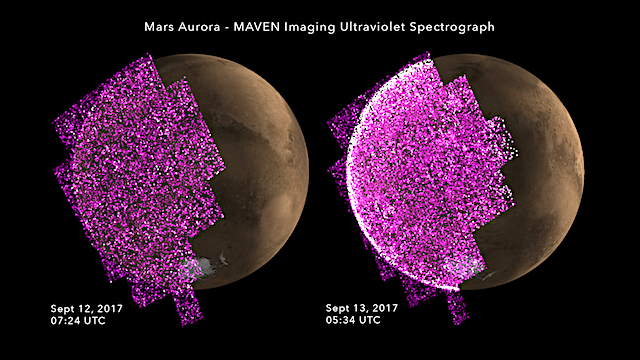 An unexpectedly strong blast from the Sun hit Mars this month, observed by NASA missions in orbit and on the surface.
An unexpectedly strong blast from the Sun hit Mars this month, observed by NASA missions in orbit and on the surface.
“NASA’s distributed set of science missions is in the right place to detect activity on the Sun and examine the effects of such solar events at Mars as never possible before,” said MAVEN Program Scientist Elsayed Talaat, program scientist for MAVEN at NASA Headquarters in Washington, D.C.
The solar event on Sept. 11, 2017 sparked a global aurora at Mars more than 25 times brighter than any previously seen by the MAVEN orbiter, which has been studying the Martian atmosphere’s interaction with the solar wind since 2014.
It produced radiation levels on the surface more than double any previously measured by the Curiosity rover’s Radiation Assessment Detector, or RAD, since that mission’s landing in 2012. The high readings lasted more than two days.
Strangely, it occurred in conjunction with a spate of solar activity during what is usually a quiet period in the Sun’s 11-year sunspot and storm-activity cycle. This event was big enough to be detected at Earth too, even though Earth was on the opposite side of the Sun from Mars.
“The current solar cycle has been an odd one, with less activity than usual during the peak, and now we have this large event as we’re approaching solar minimum,” said Sonal Jain of the University of Colorado Boulder’s Laboratory for Atmospheric and Space Physics, who is a member of MAVEN’s Imaging Ultraviolet Spectrograph instrument team.
“This is exactly the type of event both missions were designed to study, and it’s the biggest we’ve seen on the surface so far,” said RAD Principal Investigator Don Hassler of the Southwest Research Institute’s Boulder, Colorado, office. “It will improve our understanding of how such solar events affect the Martian environment, from the top of the atmosphere all the way down to the surface.” (…)
“If you were outdoors on a Mars walk and learned that an event like this was imminent, you would definitely want to take shelter, just as you would if you were on a space walk outside the International Space Station,” Hassler said. “To protect our astronauts on Mars in the future, we need to continue to provide this type of space weather monitoring there.” [More at link]








